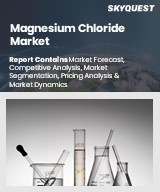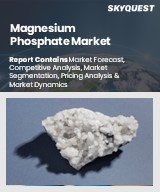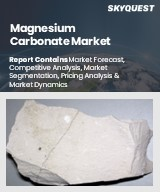
|
시장보고서
상품코드
1819763
염화마그네슘 시장 규모, 점유율, 성장 분석 : 형태별, 등급별, 유형별, 용도별, 최종사용자별, 유통 채널별, 지역별 - 산업 예측(2025-2032년)Magnesium Chloride Market Size, Share, and Growth Analysis, By Form (Flakes, Granules), By Grade (Technical grade, Food grade), By Type, By Application, By End User, By Distribution Channel, By Region - Industry Forecast 2025-2032 |
||||||
세계 염화마그네슘 시장 규모는 2023년에 5억 960만 달러로 평가되었으며, 2024년 5억 3,661만 달러에서 2032년에는 8억 1,112만 달러로 성장하여 예측 기간(2025-2032년) 동안 CAGR 5.3%로 증가할 전망입니다.
세계 염화마그네슘 시장은 먼지 억제, 제빙, 건설, 제약, 수처리 등 다양한 용도로 인해 꾸준히 성장하고 있습니다. 북미와 유럽의 도시 지역에서는 도로 제빙에 염화마그네슘을 이용하는 사례가 늘고 있으며, 기존 소금에 비해 저온에서도 효과가 있고 부식성이 낮다는 장점이 있습니다. 아시아태평양은 염화마그네슘을 콘크리트의 주 경화제 및 제조 공정의 화학 중간체로 활용하며 성장세를 이어가고 있습니다. 업계 주요 기업들은 세계 수요 증가에 대응하기 위해 공정 개선과 고효율 추출 기술에 투자하고 있습니다. 또한, 의약품, 동물 사료, 식품 가공에 염화마그네슘의 사용 확대로 시장 규모는 더욱 확대되고 있지만, 원료 가격 변동과 물류 혼란이라는 과제는 여전히 남아 있습니다.
목차
소개
- 조사 목적
- 조사 범위
- 정의
조사 방법
- 정보 조달
- 2차와 1차 데이터 방법
- 시장 규모 예측
- 시장 가정과 제한
주요 요약
- 세계 시장 전망
- 공급과 수요 동향 분석
- 부문별 기회 분석
시장 역학과 전망
- 시장 개요
- 시장 규모
- 시장 역학
- 성장 촉진요인과 기회
- 성장 억제요인과 과제
- Porters 분석
주요 시장 인사이트
- 핵심성공요인
- 경쟁 정도
- 주요 투자 기회
- 시장 생태계
- 시장 매력 지수(2024년)
- PESTEL 분석
- 거시경제 지표
- 밸류체인 분석
- 가격 분석
- 규제 상황
- 원재료 분석
염화마그네슘 시장 규모 : 형태별 & CAGR(2025-2032년)
- 시장 개요
- 플레이크
- 과립
- 분말
- 솔루션
염화마그네슘 시장 규모 : 등급별 & CAGR(2025-2032년)
- 시장 개요
- 테크니컬 등급
- 식품 등급
- 의약품 등급
- 산업용 등급
염화마그네슘 시장 규모 : 유형별 & CAGR(2025-2032년)
- 시장 개요
- 무수 염화마그네슘
- 육수화물 염화마그네슘
- 염수
염화마그네슘 시장 규모 : 용도별 & CAGR(2025-2032년)
- 시장 개요
- 제빙과 방진
- 의약품 및 퍼스널케어 제품
- 식품 및 음료
- 농업과 비료
- 산업 및 화학 프로세스
- 수처리
- 섬유와 염색
염화마그네슘 시장 규모 : 최종사용자별 & CAGR(2025-2032년)
- 시장 개요
- 건설과 인프라
- 농업
- 헬스케어
- 자동차
- 식품 및 음료
- 섬유·의류
- 화학제품
염화마그네슘 시장 규모 : 유통 채널별 & CAGR(2025-2032년)
- 시장 개요
- 오프라인
- 온라인
염화마그네슘 시장 규모 & CAGR(2025-2032년)
- 북미
- 미국
- 캐나다
- 유럽
- 독일
- 스페인
- 프랑스
- 영국
- 이탈리아
- 기타 유럽
- 아시아태평양
- 중국
- 인도
- 일본
- 한국
- 기타 아시아태평양
- 라틴아메리카
- 브라질
- 기타 라틴아메리카
- 중동 및 아프리카
- GCC 국가
- 남아프리카공화국
- 기타 중동 및 아프리카
경쟁 정보
- 상위 5개사의 비교
- 주요 기업의 시장 포지셔닝(2024년)
- 주요 시장 기업이 채용한 전략
- 최근의 시장 동향
- 기업의 시장 점유율 분석(2024년)
- 주요 기업 개요
- 기업 상세
- 제품 포트폴리오 분석
- 기업 부문별 점유율 분석
- 매출 전년비 비교(2022-2024년)
주요 기업 개요
- Compass Minerals(USA)
- ICL(Israel)
- Merck KGaA(Germany)
- NikoMag(Russia)
- K+S Aktiengesellschaft(Germany)
- Nedmag B.V.(Netherlands)
- DEUSA International GmbH(Germany)
- HuiTai Investment Co. Ltd.(China)
- Shouguang Dingsheng Chemical Co., Ltd.(China)
- Weifang Yuze Chemical Co., Ltd.(China)
- Intrepid Potash, Inc.(USA)
- Skyline Chemical Corporation(USA)
- Innovative Surface Solutions(Canada)
- Uralkali JSC(Russia)
- Stanford Advanced Materials(USA)
- Junsei Chemical Co., Ltd.(Japan)
- Sagar Life Sciences Private Limited(India)
- Bhavani Chemicals(India)
- Pallas Life Science(India)
- Univar Solutions(USA)
결론과 제안
KSM 25.09.30Global Magnesium Chloride Market size was valued at USD 509.6 million in 2023 and is poised to grow from USD 536.61 million in 2024 to USD 811.12 million by 2032, growing at a CAGR of 5.3% during the forecast period (2025-2032).
The global magnesium chloride market is experiencing consistent growth due to its diverse applications, including dust suppression, de-icing, construction, pharmaceuticals, and water treatment. Urban areas in North America and Europe are increasingly utilizing magnesium chloride for road de-icing, benefiting from its effectiveness at lower temperatures and lower corrosiveness compared to traditional salts. The Asia-Pacific region continues to thrive, leveraging magnesium chloride as a key hardening agent in concrete and a chemical intermediate in manufacturing processes. Major industry players are investing in process improvements and high-efficiency extraction technologies to meet rising global demand. Additionally, the expanding use of magnesium chloride in pharmaceuticals, animal feed, and food processing is further broadening its market reach, although challenges such as raw material price fluctuations and logistics disruptions persist.
Top-down and bottom-up approaches were used to estimate and validate the size of the Global Magnesium Chloride market and to estimate the size of various other dependent submarkets. The research methodology used to estimate the market size includes the following details: The key players in the market were identified through secondary research, and their market shares in the respective regions were determined through primary and secondary research. This entire procedure includes the study of the annual and financial reports of the top market players and extensive interviews for key insights from industry leaders such as CEOs, VPs, directors, and marketing executives. All percentage shares split, and breakdowns were determined using secondary sources and verified through Primary sources. All possible parameters that affect the markets covered in this research study have been accounted for, viewed in extensive detail, verified through primary research, and analyzed to get the final quantitative and qualitative data.
Global Magnesium Chloride Market Segments Analysis
Global Magnesium Chloride Market is segmented by Form, Grade, Type, Application, End User, Distribution Channel and region. Based on Form, the market is segmented into Flakes, Granules, Powder and Solution. Based on Grade, the market is segmented into Technical grade, Food grade, Pharmaceutical grade and Industrial grade. Based on Type, the market is segmented into Anhydrous Magnesium Chloride, Hexahydrate Magnesium Chloride and Brine Solution. Based on Application, the market is segmented into Deicing and dust control, Pharmaceuticals and personal care products, Food and beverages, Agriculture and fertilizers, Industrial and chemical processes, Water treatment and Textiles and dyeing. Based on End User, the market is segmented into Construction and infrastructure, Agriculture, Healthcare, Automotive, Food and beverage, Textile and apparel and Chemicals. Based on Distribution Channel, the market is segmented into Offline and Online. Based on region, the market is segmented into North America, Europe, Asia Pacific, Latin America and Middle East & Africa.
Driver of the Global Magnesium Chloride Market
The global magnesium chloride market is experiencing significant growth driven by its effectiveness as both a de-icer and dust suppressant. Its popularity has surged among construction companies and municipal authorities due to its lower environmental impact compared to alternative solutions. This trend is further enhanced as transportation agencies increasingly seek magnesium chloride for winter road maintenance, leading to heightened procurement activities. As a result, the market is seeing an expansion in both penetration and sales, making magnesium chloride a top choice in applications requiring effective and eco-friendly performance. Overall, this positive trajectory contributes to the market's robust development.
Restraints in the Global Magnesium Chloride Market
The global magnesium chloride market faces significant challenges stemming from the instability of raw material prices and potential supply chain disruptions related to mining and seawater extraction. Manufacturers encounter difficulties in maintaining consistent pricing for their international customers, leading to potential market volatility. Recent trends indicate that fluctuations in mineral availability and logistical constraints in regions like Asia and Europe may exacerbate these issues, hindering the growth potential of the magnesium chloride sector. Such factors contribute to a restrictive environment, limiting the overall expansion and competitiveness of the global magnesium chloride market.
Market Trends of the Global Magnesium Chloride Market
The global magnesium chloride market is witnessing a notable surge in demand driven by the increasing preference for eco-friendly de-icing solutions over traditional highway salts. This shift is particularly pronounced in Europe and North America, where cities and transportation agencies are prioritizing sustainability initiatives and adhering to stringent environmental regulations. As a result, the industry is adapting by producing higher purity and liquid formulations that enhance winter road maintenance while minimizing environmental impact and corrosion. This trend underscores the market's commitment to offering sustainable alternatives, positioning magnesium chloride as a key player in the evolving landscape of de-icing products.
Table of Contents
Introduction
- Objectives of the Study
- Scope of the Report
- Definitions
Research Methodology
- Information Procurement
- Secondary & Primary Data Methods
- Market Size Estimation
- Market Assumptions & Limitations
Executive Summary
- Global Market Outlook
- Supply & Demand Trend Analysis
- Segmental Opportunity Analysis
Market Dynamics & Outlook
- Market Overview
- Market Size
- Market Dynamics
- Drivers & Opportunities
- Restraints & Challenges
- Porters Analysis
- Competitive rivalry
- Threat of substitute
- Bargaining power of buyers
- Threat of new entrants
- Bargaining power of suppliers
Key Market Insights
- Key Success Factors
- Degree of Competition
- Top Investment Pockets
- Market Ecosystem
- Market Attractiveness Index, 2024
- PESTEL Analysis
- Macro-Economic Indicators
- Value Chain Analysis
- Pricing Analysis
- Regulatory Landscape
- Raw Material Analysis
Global Magnesium Chloride Market Size by Form & CAGR (2025-2032)
- Market Overview
- Flakes
- Granules
- Powder
- Solution
Global Magnesium Chloride Market Size by Grade & CAGR (2025-2032)
- Market Overview
- Technical grade
- Food grade
- Pharmaceutical grade
- Industrial grade
Global Magnesium Chloride Market Size by Type & CAGR (2025-2032)
- Market Overview
- Anhydrous Magnesium Chloride
- Hexahydrate Magnesium Chloride
- Brine Solution
Global Magnesium Chloride Market Size by Application & CAGR (2025-2032)
- Market Overview
- Deicing and dust control
- Pharmaceuticals and personal care products
- Food and beverages
- Agriculture and fertilizers
- Industrial and chemical processes
- Water treatment
- Textiles and dyeing
Global Magnesium Chloride Market Size by End User & CAGR (2025-2032)
- Market Overview
- Construction and infrastructure
- Agriculture
- Healthcare
- Automotive
- Food and beverage
- Textile and apparel
- Chemicals
Global Magnesium Chloride Market Size by Distribution Channel & CAGR (2025-2032)
- Market Overview
- Offline
- Online
Global Magnesium Chloride Market Size & CAGR (2025-2032)
- North America (Form, Grade, Type, Application, End User, Distribution Channel)
- US
- Canada
- Europe (Form, Grade, Type, Application, End User, Distribution Channel)
- Germany
- Spain
- France
- UK
- Italy
- Rest of Europe
- Asia Pacific (Form, Grade, Type, Application, End User, Distribution Channel)
- China
- India
- Japan
- South Korea
- Rest of Asia-Pacific
- Latin America (Form, Grade, Type, Application, End User, Distribution Channel)
- Brazil
- Rest of Latin America
- Middle East & Africa (Form, Grade, Type, Application, End User, Distribution Channel)
- GCC Countries
- South Africa
- Rest of Middle East & Africa
Competitive Intelligence
- Top 5 Player Comparison
- Market Positioning of Key Players, 2024
- Strategies Adopted by Key Market Players
- Recent Developments in the Market
- Company Market Share Analysis, 2024
- Company Profiles of All Key Players
- Company Details
- Product Portfolio Analysis
- Company's Segmental Share Analysis
- Revenue Y-O-Y Comparison (2022-2024)
Key Company Profiles
- Compass Minerals (USA)
- Company Overview
- Business Segment Overview
- Financial Updates
- Key Developments
- ICL (Israel)
- Company Overview
- Business Segment Overview
- Financial Updates
- Key Developments
- Merck KGaA (Germany)
- Company Overview
- Business Segment Overview
- Financial Updates
- Key Developments
- NikoMag (Russia)
- Company Overview
- Business Segment Overview
- Financial Updates
- Key Developments
- K+S Aktiengesellschaft (Germany)
- Company Overview
- Business Segment Overview
- Financial Updates
- Key Developments
- Nedmag B.V. (Netherlands)
- Company Overview
- Business Segment Overview
- Financial Updates
- Key Developments
- DEUSA International GmbH (Germany)
- Company Overview
- Business Segment Overview
- Financial Updates
- Key Developments
- HuiTai Investment Co. Ltd. (China)
- Company Overview
- Business Segment Overview
- Financial Updates
- Key Developments
- Shouguang Dingsheng Chemical Co., Ltd. (China)
- Company Overview
- Business Segment Overview
- Financial Updates
- Key Developments
- Weifang Yuze Chemical Co., Ltd. (China)
- Company Overview
- Business Segment Overview
- Financial Updates
- Key Developments
- Intrepid Potash, Inc. (USA)
- Company Overview
- Business Segment Overview
- Financial Updates
- Key Developments
- Skyline Chemical Corporation (USA)
- Company Overview
- Business Segment Overview
- Financial Updates
- Key Developments
- Innovative Surface Solutions (Canada)
- Company Overview
- Business Segment Overview
- Financial Updates
- Key Developments
- Uralkali JSC (Russia)
- Company Overview
- Business Segment Overview
- Financial Updates
- Key Developments
- Stanford Advanced Materials (USA)
- Company Overview
- Business Segment Overview
- Financial Updates
- Key Developments
- Junsei Chemical Co., Ltd. (Japan)
- Company Overview
- Business Segment Overview
- Financial Updates
- Key Developments
- Sagar Life Sciences Private Limited (India)
- Company Overview
- Business Segment Overview
- Financial Updates
- Key Developments
- Bhavani Chemicals (India)
- Company Overview
- Business Segment Overview
- Financial Updates
- Key Developments
- Pallas Life Science (India)
- Company Overview
- Business Segment Overview
- Financial Updates
- Key Developments
- Univar Solutions (USA)
- Company Overview
- Business Segment Overview
- Financial Updates
- Key Developments



















